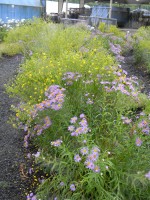by Jonathan Bolden, Roots of Success Instructor, Coyote Ridge Corrections Center
Photos by DOC staff

Jonathan Bolden was certified as a Roots of Success instructor in May, 2015. Since then, he has co-taught the environmental curriculum six times.
Too often we assume that the concept of sustainability is exclusive to the realm of environmental justice. That somehow the idea of conserving natural resources, protecting endangered species and habitats, or reducing our energy consumption will automatically result in a healed earth.
This assumption overlooks the most important factor in actually employing sustainability approaches and practices to meet the growing demands of environmental justice—the human being.
Transforming our earth requires the transformation of people, more specifically, the transformation of people’s attitudes and behavior, as it relates to the environment. The greatest potential and need for this change to occur exists within prisons.
Society has condemned and confined prisoners to prison because of their unsustainable (criminal) behavior. Their behavior has wreaked havoc and devastation within communities similar to the unsustainable human behavior that has led to the environmental crises we currently face. In this sense, the sustainability concept not only applies to radically improving our relationship with the earth and environment but also in our effort to redeem, reform, and rehab[ilitate] prisoners.
Einstein once said that the current dilemmas we face could not be solved at the same intellectual level in which they were created. We are going to have to revolutionize our thinking in how we establish responsible environmental and criminal justice practices. What better way to achieve this goal than to incorporate the solution of one with the other.
The Sustainability in Prisons Project (SPP) and Roots of Success program (Roots) puts this wisdom of Einstein into practice. These types of programs provide prisoners with the necessary skills and experience to successfully reintegrate into society and find employment in the green economy.

Roots instructors Julian Reyes, Jonathan Bolden, and Eugene Youngblood pose at a graduation event.
At Coyote Ridge Corrections Center (CRCC), SPP creates programs and opportunities for prisoners to engage in sustainability activities. For instance, the sagebrush project allows prisoners to acquire experience with the native plants of Washington State. The sagebrush plays an essential role in the eastern Washington landscape, as it provides numerous species with food and shelter. If the sagebrush were to become threatened or even extinct, this would have serious implications for the Washington State wildlife.

A technician in the sagebrush program at Coyote Ridge Corrections Center checks the health of a plant plug. Photo by Jeff Clark, Bureau of Land Management.
In addition, the Roots course empowers prisoners with its environmental literacy curriculum. While it builds environmental understanding, it also focuses on building the individual student. This means students are challenged to assess their attitude and behavior toward the environment and by extension their attitude and behavior toward society. By introducing the green economy and green jobs to students, Roots highlights the opportunity for students to become gainfully employed and be a veritable solution to our environmental problems.
Ultimately, what we do today determines our tomorrow. SPP and Roots are planting seeds that are sure to bear the fruit of sustainability and justice. So let us take a cue from these programs and dig our hands into the dirt to cultivate a better future.



















 Gig Harbor, Wash.—Emphasizing the importance of sustainability, the horticulture program at
Gig Harbor, Wash.—Emphasizing the importance of sustainability, the horticulture program at  “Because each offender demonstrated a high capacity of responsibility for day-to-day farm activities, I decided to assign special projects for each lady,” Little said. “The project idea was a way for the offenders to take ownership of the farm, learn something new and educate each other on their respective projects. Being a part of the learning process was an enriching experience as a manager, and I look forward to working with Washington Corrections Center for Women to explore new boundaries, build knowledge and experiences and work together to fight hunger.”
“Because each offender demonstrated a high capacity of responsibility for day-to-day farm activities, I decided to assign special projects for each lady,” Little said. “The project idea was a way for the offenders to take ownership of the farm, learn something new and educate each other on their respective projects. Being a part of the learning process was an enriching experience as a manager, and I look forward to working with Washington Corrections Center for Women to explore new boundaries, build knowledge and experiences and work together to fight hunger.”























